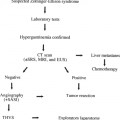
PAVMs: A Pulmonologist’s Perspective
Although family practitioners and general internists often view the patient with pulmonary arteriovenous malformations (PAVMs) as an unfamiliar problem to be quickly referred to the nearest pulmonologist, geneticist, or surgeon, the pulmonologist tends to view these patients as having interesting pulmonary gas-exchange abnormalities and the potential to develop life-threatening infections, hemorrhage, or embolic phenomena.
Recently, acquired knowledge about the genetics, pathophysiology, prognosis, and, most importantly, advances in treatment has allowed physicians to feel much more comfortable when discussing disease progression, complications, and therapeutic options with patients.
This chapter discusses this newly gained knowledge from the perspective of the pulmonologist.
 Definition
Definition
A PAVM may be described pathophysiologically as a direct connection between the pulmonary artery and vein, which, by virtue of the absence of a normal alveolar-capillary interface, bypasses the normal gas exchange units of the lung.
Pulmonary arteriovenous malformations may be subdivided anatomically into simple and complex malformations, a simple PAVM defined as a single feeding pulmonary arterial vessel connecting with a nonseptated aneurysmal sac and draining pulmonary vein, and a complex PAVM defined as having more than one feeding pulmonary arterial vessel leading into a septated vascular structure with one or more draining pulmonary veins.
 Epidemiology
Epidemiology
Congenital PAVMs may occur spontaneously without apparent accompanying developmental abnormalities, or they may be found in association with hereditary hemorrhagic telangiectasia (HHT), alternatively known as Osier-Weber-Rendu disease (OWR). Occasionally, PAVMs are acquired secondary to other diseases, such as thyroid carcinoma or traumatic chest injury.
Although accurate large-scale studies have not been performed to estimate precisely the prevalence of PAVMs in the general population, a preliminary study suggested that the prevalence approximates 100,000 to 200,000 population, although it may be much higher in populations where HHT is indigenous.1 Within families with HHT, it has been estimated that about 15% of family members have pulmonary manifestations of the disease.2
Conversely, when series of patients with PAVMs are examined, between 36 and 57% have HHT.3,4 The likelihood of having HHT is greater if the patient has multiple PAVMs rather than a single lesion.
 Genetics
Genetics
The genetic abnormalities of PAVMs in non-HHT patients are unknown; however HHT, an autosomal dominant disease, has been localized to two chromosomes: 9q and 12q. Additional chromosomes are likely to be affected. Early studies suggest that about 30% of patients from families with chromosome 9q linkage have PAVMs, whereas fewer than 5% of families with the chromosome 12q locus have clinically evident PAVMs. There is presently no clinical genetic test available to determine the chromosomal abnormality of patients with HHT.
 Clinical Presentation
Clinical Presentation
Patients may present with symptoms caused by PAVMs or may have their malformation(s) discovered coincidentally when a chest roentgenogram is performed for other reasons. Symptomatic patients may present with complaints that are a consequence of physiologic aberrations of gas exchange or because of other complications resulting from these unusual anatomic structures. The most common complaint due to altered gas exchange is that of dyspnea associated with hypoxemia. This hypoxemia is often positional (orthodeoxia), being most pronounced when sitting or standing. Significant hypoxemia usually is associated with multiple PAVMs. Other symptoms commonly found accompanying the dyspnea include chronic fatigue, intermittent dizziness, and headaches.
Symptoms attributable to complications of PAVMs include those resulting from rupture of the abnormal vessels and those thought to be caused by the loss of the normal filtering function of the lungs. Rupture of a PAVM endobronchially may result in hemoptysis, and rupture into the pleural space may result in hemothorax and the symptoms commonly accompanying blood loss.
Patients with PAVMs may present with symptoms and signs of a stroke or brain abscess caused by blood bypassing the filtering function of the capillary bed of the pulmonary vasculature. Because PAVMs occur commonly in younger persons, an unexplained stroke or brain abscess in early or middle adulthood always should raise the question of the presence of PAVMs. The size and number of malformations do not correlate closely with the likelihood of stroke or brain abscess.
Other signs of PAVMs include clubbing, cyanosis, a bruit over a lesion, and the presence of telangiectasia if the patient has HHT. One or more of these signs may be found in as many as 75% of patients with careful examination.4 To develop sufficient hypoxemia to cause dyspnea, clubbing, and cyanosis, the patient usually must have at least 15 to 20% of the cardiac output shunted through the PAVMs.
 Laboratory Studies
Laboratory Studies
Secondary polycythemia is commonly found in patients with significant arterial hypoxemia, although it resolves with adequate embolotherapy or surgical correction. Conversely, anemia also may be found in some patients with PAVMs and HTT who have gastrointestinal or nasal AVMs that periodically bleed.
Arterial blood gases demonstrate hypoxemia of varying degrees, dependent on the percentage of cardiac output shunted through the PAVMs and the position in which the blood gases are taken. Arterial oxygen tension decreases when going from the supine to the sitting to the standing position. Hypocarbia commonly accompanies the hypoxemia, and frequently a compensated respiratory alkalosis is noted.
Pulmonary function tests frequently demonstrate a diffusing capacity that is reduced proportional to the degree of shunting. The explanation for this reduction is unclear, but it may reflect increased areas of dead space within the lungs of these patients caused by the shunting of blood through the PAVMs.5
 Pathophysiology
Pathophysiology
Stay updated, free articles. Join our Telegram channel

Full access? Get Clinical Tree



